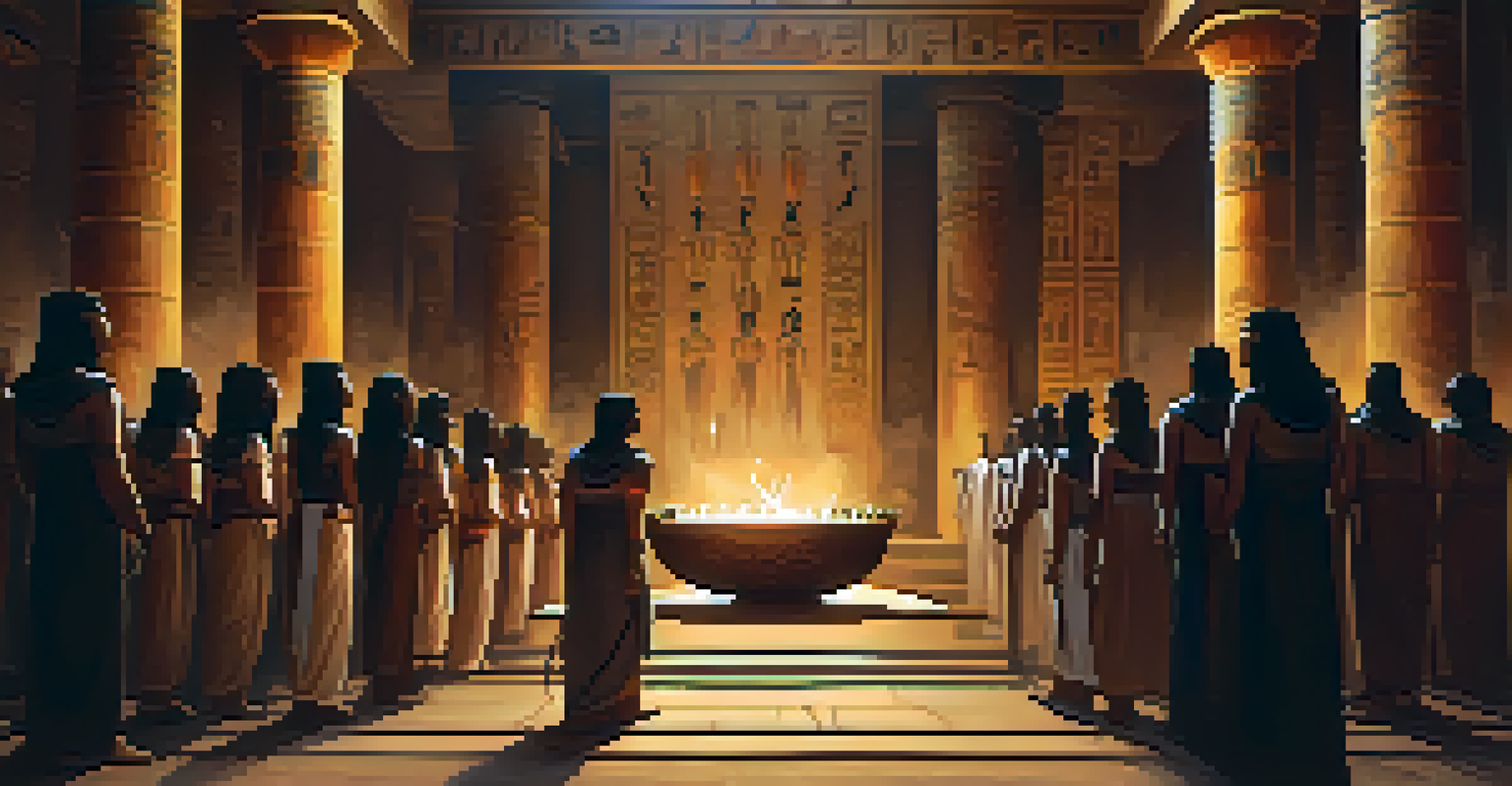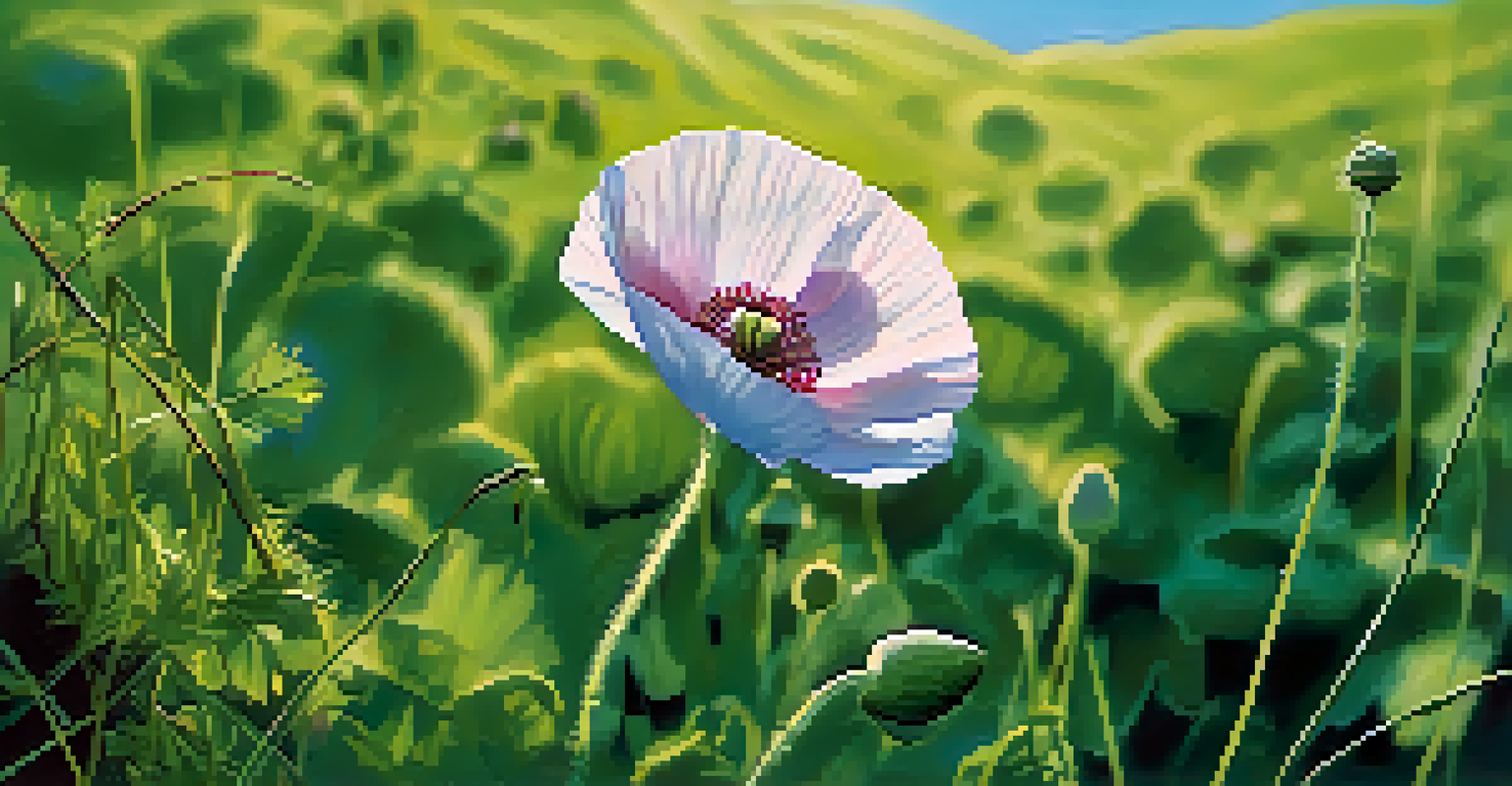Mystical Experiences: Entheogens in Ancient Egyptian Texts

Introduction to Mystical Experiences in Ancient Egypt
Ancient Egypt, a civilization steeped in mystery, often used entheogens for spiritual practices. These substances were believed to connect individuals with the divine, altering consciousness and facilitating mystical experiences. By examining ancient texts, we can uncover how these practices shaped their understanding of the cosmos and spirituality.
The use of entheogens has been a path to spiritual enlightenment for millennia, guiding seekers on their journey to connect with the divine.
Entheogens are naturally occurring substances that can induce altered states of consciousness, often used in religious or spiritual contexts. In ancient Egypt, plants like blue lotus and various fungi likely held significant spiritual importance. Understanding these substances provides insight into the rituals and beliefs of this fascinating civilization.
The use of entheogens wasn't just about intoxication; it was a means to achieve higher states of awareness. This pursuit of transcendence can be seen in various inscriptions and artifacts, indicating a profound relationship between humanity and the divine in ancient Egyptian culture.
Key Entheogens in Ancient Egyptian Practices
Several specific plants and substances played pivotal roles in ancient Egyptian spiritual practices. The blue lotus, known for its psychoactive properties, was often depicted in art and mythology, symbolizing rebirth and enlightenment. Its use in rituals suggests that it was a gateway to deeper understanding and mystical experiences.

Another notable entheogen is the opium poppy, which may have been used to induce states of euphoria and altered perception. Textual references and archaeological findings hint at its role in ceremonies aimed at healing or divination. These substances were not merely recreational; they were deeply tied to the culture’s spiritual framework.
Entheogens Foster Spiritual Connection
Ancient Egyptians used entheogens to connect with the divine, facilitating mystical experiences and deeper understanding of spirituality.
Additionally, certain fungi, likely hallucinogenic in nature, may have been used in secretive rites. The careful selection and preparation of these plants indicate a sophisticated understanding of their effects, showcasing the ancient Egyptians' commitment to exploring the boundaries of human consciousness.
The Role of Rituals in Enhancing Mystical Experiences
Rituals in ancient Egypt were meticulously structured, often incorporating entheogens to enhance the experience. These ceremonies provided a communal space for individuals to connect with the divine, fostering a sense of unity and shared purpose. The atmosphere of these rituals was designed to heighten sensory perception and spiritual awareness.
In the sacred texts, the experiences induced by entheogens reveal a profound understanding of the cosmos and our place within it.
The interplay between music, dance, and the use of entheogens created an immersive experience that transcended ordinary reality. Participants often reported visions and profound insights, reinforcing the belief that these rituals were pathways to higher knowledge. This holistic approach highlights the importance of community in spiritual exploration.
Moreover, the timing of these rituals, often aligned with celestial events, further amplified their significance. The ancient Egyptians believed that the cosmos played a crucial role in their spiritual practices, and by synchronizing their rituals with these cycles, they sought to tap into universal energies for guidance and enlightenment.
Mystical Experiences Documented in Sacred Texts
Ancient Egyptian texts, such as the Pyramid Texts and the Book of the Dead, offer glimpses into the mystical experiences facilitated by entheogens. These writings often describe encounters with divine beings and the transformative journeys of the soul. Such accounts suggest that entheogens were integral to their understanding of life, death, and the afterlife.
For instance, the imagery of the blue lotus in these texts symbolizes not only beauty but also spiritual awakening and enlightenment. The descriptions of transcendental experiences provide evidence that these substances were revered as sacred tools for communion with the divine. This notion elevates the use of entheogens beyond mere experimentation to a vital aspect of their spiritual practice.
Rituals Enhanced Mystical Experiences
Meticulously structured rituals, often incorporating entheogens, created communal spaces that heightened spiritual awareness and sensory perception.
Additionally, the symbolism and metaphors used in these sacred texts reflect a rich tapestry of beliefs regarding the human experience. By decoding these symbols, modern readers can gain insights into the profound spiritual journeys undertaken by the ancient Egyptians, guided by the influence of entheogens.
The Connection Between Entheogens and Egyptian Deities
In ancient Egyptian culture, deities played a central role in the spiritual lives of individuals. Many entheogens were associated with specific gods and goddesses, believed to facilitate direct communication with these divine beings. For example, the blue lotus was linked to the sun god Ra, symbolizing rebirth and enlightenment.
Rituals involving entheogens often included invocations to these deities, seeking their guidance and favor. The altered states induced by these substances were thought to bring individuals closer to the divine, allowing for a more profound relationship with the gods. This connection reflects a unique interplay between human experience and divine influence.
Moreover, the attributes of these deities often mirrored the effects of the entheogens. For instance, the ecstatic states induced by these substances could be seen as a manifestation of divine presence, reinforcing the idea that the spiritual and the material were intertwined in ancient Egyptian belief systems.
Modern Perspectives on Ancient Egyptian Entheogen Use
Today, there is a renewed interest in the use of entheogens for spiritual exploration, drawing parallels with ancient practices. Researchers and spiritual seekers alike are exploring how these substances can facilitate mystical experiences similar to those documented in ancient Egyptian texts. This modern revival acknowledges the historical significance of entheogens in spiritual traditions.
As we learn more about the potential benefits of entheogens, there is a growing appreciation for their role in expanding consciousness. The exploration of these substances can lead to insights about the self and the universe, echoing the ancient Egyptians' quest for knowledge and enlightenment. This connection to the past enriches contemporary spiritual practices.
Modern Interest in Ancient Practices
Today's spiritual seekers are exploring the historical significance of entheogens, drawing parallels with ancient Egyptian practices for consciousness expansion.
However, it's essential to approach this revival with respect and understanding of the cultural contexts from which these practices emerged. By honoring the traditions of ancient Egypt, we can create a more authentic and meaningful dialogue about the role of entheogens in our spiritual journeys today.
Conclusion: The Enduring Legacy of Entheogens in Spirituality
The use of entheogens in ancient Egypt reveals a deep and complex relationship between spirituality and altered states of consciousness. These substances were not merely tools for escape but gateways to profound mystical experiences that shaped their understanding of existence. As we explore this legacy, we gain valuable insights into the human quest for connection with the divine.
By studying the rituals, texts, and beliefs of the ancient Egyptians, we uncover timeless truths about the nature of consciousness and the spiritual journey. Their reverence for entheogens reminds us that the search for enlightenment is a universal pursuit, transcending time and culture. This legacy continues to inspire modern seekers and scholars alike.

Ultimately, the enduring influence of entheogens in spirituality invites us to reflect on our own practices and beliefs. As we navigate our spiritual paths, we can look to the wisdom of ancient Egypt, recognizing that the quest for understanding and connection with the divine is as relevant today as it was millennia ago.